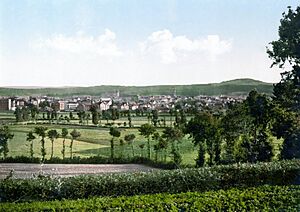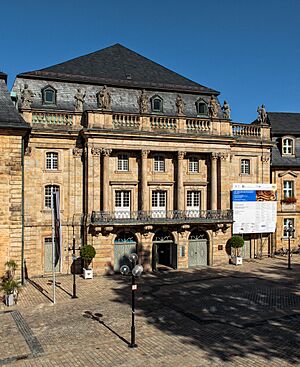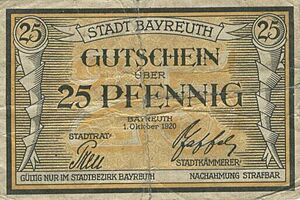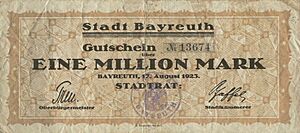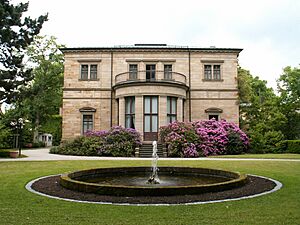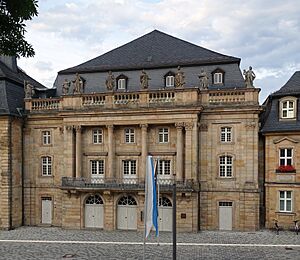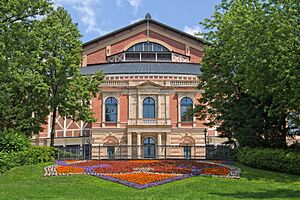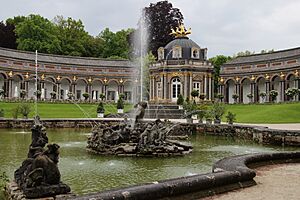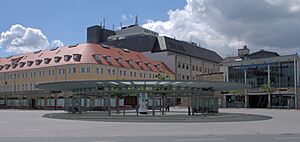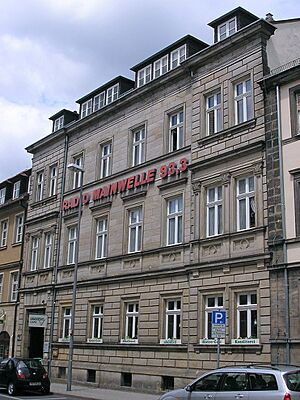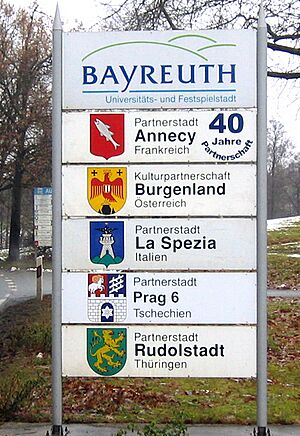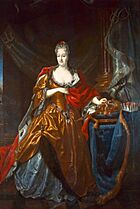Bayreuth facts for kids
Quick facts for kids
Bayreuth
|
|||
|---|---|---|---|
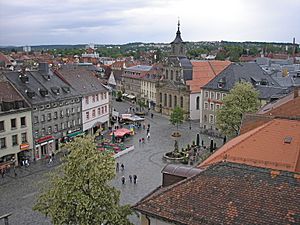
Town square
|
|||
|
|||
| Lua error in Module:Location_map at line 530: Unable to find the specified location map definition: "Module:Location map/data/Germany Bayern" does not exist. | |||
| Country | Germany | ||
| State | Bavaria | ||
| Admin. region | Upper Franconia | ||
| District | Urban district | ||
| Area | |||
| • Total | 66.92 km2 (25.84 sq mi) | ||
| Elevation | 340 m (1,120 ft) | ||
| Population
(2022-12-31)
|
|||
| • Total | 74,506 | ||
| • Density | 1,113.36/km2 (2,883.59/sq mi) | ||
| Time zone | UTC+01:00 (CET) | ||
| • Summer (DST) | UTC+02:00 (CEST) | ||
| Postal codes |
95401–95448
|
||
| Dialling codes | 0921, 09201, 09209 | ||
| Vehicle registration | BT | ||
| Website | www.bayreuth.de | ||
Bayreuth is a city in northern Bavaria, Germany. It sits by the Red Main river, in a valley between the Franconian Jura and the Fichtel Mountains. The city started around 1194. Today, it is the main city of Upper Franconia and has about 72,000 people. Bayreuth is famous for its yearly Bayreuth Festival. This festival shows operas by the German composer Richard Wagner, who lived in the 1800s.
Contents
History
Early Times and Middle Ages
People think the city of Bayreuth was started by the counts of Andechs. This was likely in the mid-1100s. The first time Bayreuth was written about was in 1194. It was called Baierrute. The name might mean "clearing" (Rodung) and shows that people from the Bavarian region settled there.
Some villages that later became part of Bayreuth are even older. Seulbitz was mentioned in 1035. St. Johannis might have been mentioned in 1149. The area of Altstadt (Old Town) is also older than Bayreuth itself. Even older signs of people living here, like pottery, have been found from the 800s.
In 1199, Bayreuth was called a "village." But in 1231, it was called a "town." This means Bayreuth likely became an official town between 1200 and 1230. The counts of Andechs-Merania ruled the town until 1248. After them, the Hohenzollern family from Nuremberg took over in 1260.
In 1361, Emperor Charles IV gave the ruler of Nuremberg the right to make coins for Bayreuth and Kulmbach.
In 1398, Bayreuth became its own area, called the Principality of Bayreuth. But the main city of this area was Kulmbach until 1604. Bayreuth grew slowly and faced many problems.
Bayreuth first appeared on a map in 1421. In February 1430, the Hussites attacked Bayreuth. They destroyed the town hall and churches.
By 1528, the rulers of the Bayreuth area changed to the Lutheran faith. This was less than ten years after the start of the the Reformation.
In 1605, a big fire destroyed many houses in Bayreuth. In 1620, the plague spread. In 1621, another large fire happened. The city also suffered during the Thirty Years' War.
A big change for Bayreuth happened in 1603. Margrave Christian moved his royal home from Kulmbach to Bayreuth. The first Hohenzollern palace was built between 1440 and 1457. This was the start of today's Old Palace. It was made bigger and improved many times.
The growth of the new capital slowed down because of the Thirty Years' War. But after the war, many beautiful baroque buildings were added. After Christian died in 1655, his grandson, Christian Ernest, became ruler. He ruled from 1661 to 1712. He was a smart and well-traveled man. He started a grammar school. In 1683, he helped free Vienna from a siege. To remember this, he had the Margrave Fountain built. It shows him as a hero. During his time, the outer town wall and the castle chapel were also built.
The 1700s
Christian Ernest's son, George William, started a new town in 1701. It was called St Georgen am See (now a district of Bayreuth). It had a castle, a town hall, and a prison. In 1705, he started a special group called the Order of Sincerity. He also had a church built, which finished in 1711. In 1716, a factory for making porcelain was set up in St. Georgen.
The first "castle" in the Hermitage park was built by Margrave George William between 1715 and 1719.
In 1721, the town council bought a palace to use as the new Town Hall. This is today's Old Town Hall.
Bayreuth had its "Golden Age" when Margrave Frederick and Margravine Wilhelmina ruled (1735–1763). Wilhelmina was the favorite sister of Frederick the Great. During this time, many grand buildings were created. These included the Margravial Opera House (1744–1748), the New Castle and Sun Temple at the Hermitage (1749–1753), and the New Palace (1754 onwards). The New Palace replaced the Old Palace, which had burned down. The beautiful buildings on today's Friedrichstraße were also built. There was even a special building style called Bayreuth Rococo.
Old, dark gatehouses were taken down because they made travel hard. Margrave Frederick kept his area out of wars, bringing peace to the region.
In 1742, the Frederick Academy was founded. It became a university in 1743. But it moved to Erlangen that same year because of problems with the local people. It is still there today. From 1756 to 1763, there was also an Academy of Arts and Sciences.
Catholic people were allowed to have a prayer room. Jewish families also settled here again. In 1760, the synagogue opened. In 1787, the Jewish cemetery was dedicated.
Countess Wilhelmina died in 1758. After Margrave Frederick died in 1763, many artists moved away. This was because the next ruler, Margrave Frederick Christian, did not care much for art. He also had less money because of the previous ruler's grand lifestyle. By 1769, the area was almost out of money.
In 1769, Margrave Charles Alexander took over. He lived in Ansbach, so Bayreuth became a less important home.
In 1791, the last Margrave, Charles Alexander, gave up his rule. Bayreuth then became part of a Prussian area.
The center of Bayreuth still looks like an old Bavarian market town. Buildings are around a wide road that forms a square. The Town Hall was in the middle. The church was separate, and the castle was on a small hill.
The 1800s
In 1804, the writer Jean Paul Richter moved to Bayreuth. He lived there until he died in 1825.
The Hohenzollern family's rule over Bayreuth ended in 1806. This was after Prussia lost to Napoleon's France. From 1806 to 1810, France controlled Bayreuth. The city had to pay a lot of money for the war. In 1810, France sold the area to the Kingdom of Bavaria for 15 million francs. Bayreuth became the capital of a Bavarian district, which later became Upper Franconia.
When railways came to Bavaria, the main line did not go directly through Bayreuth. Bayreuth got its first railway connection in 1853. The city paid for this line itself. More railway lines were built in the following years, connecting Bayreuth to other towns.
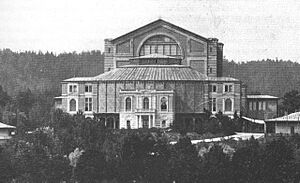
On April 17, 1870, Richard Wagner visited Bayreuth. He had heard about the Margrave Opera House. Its large stage seemed perfect for his operas. However, the orchestra pit was too small for his many musicians. So, he decided to build his own special festival hall in Bayreuth. The city helped him by giving him land for it. This land was outside the city, between the railway station and a hill called Hohe Warte. It was known as the "Green Hill." Wagner also bought land nearby to build his own house, called Wahnfried.
On May 22, 1872, the first stone for the Festival Hall was laid. On August 13, 1876, it officially opened. This was the start of the famous Bayreuth Festival. The architect, Otto Brückwald, designed the hall.
In 1886, the composer Franz Liszt died in Bayreuth. He was visiting his daughter Cosima Liszt, who was Wagner's widow. Both Liszt and Wagner are buried in Bayreuth. Wagner himself died in Venice in 1883, but his family brought his body to Bayreuth for burial.
The 1900s
Early 1900s to the Weimar Republic (1900–1933)
The new century brought modern changes. In 1892, the first electric street lights appeared. In 1908, the city got an electricity station and its first cinema.
After First World War ended in 1918, a Workers' and Soldiers' Council briefly took power in Bayreuth. In 1919, there was a small, short event called the Speckputsch.
In 1923, a large nationalist event called "Deutscher Tag" (German Day) took place in Bayreuth. Over 3,300 people gathered. Adolf Hitler was a speaker and was invited to the Wagner family home, Wahnfried.
In 1932, the areas of Upper and Middle Franconia were joined. Ansbach became the main city for this new area. Bayreuth received a state insurance agency as a small comfort.
Nazi Era (1933–1945)
Bayreuth became an important city for the Nazi party. In 1933, it was made the capital of the Nazi region called "Bavarian Eastern March." Nazi leaders often visited the Wagner festival. They tried to make Bayreuth a special Nazi city. Hitler loved Richard Wagner's music and became friends with Winifred Wagner, who ran the festival. Hitler often attended Wagner performances.
Bayreuth was planned to have a large Nazi government building and marching square. The first Nazi leader for Bayreuth was Hans Schemm.
During this time, the synagogue of the Jewish community was damaged and robbed during a difficult event. However, it was not completely destroyed because it was close to the Opera House. Today, the building is used again by a Jewish community as a synagogue. A plaque inside remembers the Jewish people who suffered and died during the Shoah. At least 145 Jewish people from Bayreuth lost their lives.
During World War II, a small camp for prisoners was set up in Bayreuth. Prisoners there were forced to take part in physical tests. Wieland Wagner, Richard Wagner's grandson, was involved with this camp for a short time.
On April 5, 8, and 11, 1945, about one-third of Bayreuth was destroyed by heavy air attacks. Many public buildings, factories, and 4,500 houses were ruined. 741 people died. On April 14, the U.S. Army took control of the city.
After the War (1945–2000)
After the war, Bayreuth worked to move past its difficult history. It became part of the American Zone. The American military set up a camp for displaced persons (DPs), many of whom were Ukrainian.
The housing situation was very hard. There were about 53,300 people in the city, much more than before the war. This was because many refugees came. Even in 1948, over 11,000 refugees were counted. Many homes were destroyed, so thousands lived in temporary shelters. The festival restaurant even housed about 500 people.
In 1945, 1,400 men were asked to help clean up damaged buildings and clear roads. Many historic buildings were taken down after the war. But cultural life quickly returned. In 1947, a Mozart festival was held in the Opera House. In 1949, the Festival Hall was used again for a concert. In 1951, the first Richard Wagner Festival after the war took place. It was led by Wieland and Wolfgang Wagner. Wieland Wagner's new ways of staging operas helped the theater regain its good name after the Nazi era.
In 1949, Bayreuth became the main city for the government of Upper Franconia again.
In 1971, the Bavarian State Parliament decided to create the University of Bayreuth. It opened in 1975. Today, about 10,000 students study in the city.
In May 1972, a serious accident happened at the folk festival. An overloaded roller coaster car went off its tracks. Four people died and five were hurt. This was the worst roller coaster accident in Germany since World War II at that time.
In 1999, the world gliding championship was held at Bayreuth's airport.
The 2000s
In 2006, Bayreuth chose its first mayor from the CSU party, Michael Hohl. In 2007, a Youth Parliament was elected for the first time. It had 12 young people aged 14–17. Also in 2007, a new bus station opened.
| Largest groups of foreign residents | |
| Nationality | Population (2013) |
|---|---|
| 938 | |
| 434 | |
| 364 | |
| 336 | |
| 291 | |
Richard Wagner and Bayreuth
Bayreuth is most famous for its connection to the composer Richard Wagner. He lived in Bayreuth from 1872 until he died in 1883. Wagner's house, "Wahnfried", was built in Bayreuth with help from King Ludwig II of Bavaria. After World War II, it became a Wagner Museum.
In the northern part of Bayreuth is the Festival Hall. This opera house was built especially for Wagner's operas. Only his operas are performed there. The first performances of parts of Wagner's famous Ring Cycle and Parsifal happened here.
Every summer, Wagner's operas are performed at the Festspielhaus during the month-long Richard Wagner Festival. This festival is often called the Bayreuth Festival. Thousands of people come each year. Tickets have been sold out since it started in 1876. Sometimes, people have to wait 10 years or more for tickets!
The first Bayreuth festival was important for the philosopher Friedrich Nietzsche. He was a big fan of Wagner's music at first. But he later became unhappy with the festival. He thought it showed society was going wrong.
Geography
Location
Bayreuth is on the Red Main river. This river is one of the two main sources of the larger Main river. Bayreuth is located between the Fichtelgebirge Mountains and Franconian Switzerland. The city is also part of the larger Nuremberg Metropolitan Region.
City Areas
The city of Bayreuth is divided into 39 districts. Some of these include:
- 1: Westliche Innenstadt (Western city center)
- 2: Östliche Innenstadt/Obere Röth (Eastern city center)
- 3: Cosima-Wagner-Straße/ Nürnberger Straße/Universitätsstraße
- 4: Südöstliche Innenstadt (Southeastern city center)
- 5: Südwestliche Innenstadt (Southwestern city center)
- 6: Birken
- 7: Justus-Liebig-Straße/Quellhöfe/Rückertweg
- 8: Leuschnerstraße/Ludwig-Thoma-Straße
- 9: Saas, an old village mentioned in 1528
- 10: Bismarckstraße/Friedrichstraße/Moritzhöfen
- 11: Freiheitsplatz/Malerviertel
- 12. Erlanger Straße/Wolfsgasse
- 13: Jakobshof
- 14: Hetzennest/Braunhof/Fantaisiestraße
- 15: Meyernberg
- 16: Nördlicher Roter Hügel
- 17: Grüner Hügel/Wendelhöfen
- 18: Kreuz
- 19: Herzoghöhe/Am Bauhof
- 20: Nördliche Innenstadt
- 21: Carl-Schüller-Straße/Bürgerreuther Straße/Gutenbergstraße
- 22: Gartenstadt
- 23: Bürgerreuth/Gravenreutherstraße
- 24: Sankt Georgen (Bayreuth)/Grüner Baum/Burg
- 25: Östliche Hammerstatt
- 26: Westliche Hammerstatt
- 27: Bernecker Straße/Insel/Riedelsberg
- 28: Industriegebiete St. Georgen
- 29: St. Johannis
- 30: Neue Heimat
- 31: Oberkonnersreuth
- 32: Laineck
- 33: Westlicher Roter Hügel
- 34: Eubener Straße/Furtwänglerstraße/Schupfenschlag/Hohe Warte
- 35: Seulbitz
- 36: Aichig/Grunau
- 37: Thiergarten/Destuben
- 38: Oberpreuschwitz
- 39: Wolfsbach
Climate
Bayreuth has a climate with mild differences between hot and cold. It gets enough rain all year. This climate is called "Humid continental" or "Marine West Coast."
| Climate data for Bayreuth | |||||||||||||
|---|---|---|---|---|---|---|---|---|---|---|---|---|---|
| Month | Jan | Feb | Mar | Apr | May | Jun | Jul | Aug | Sep | Oct | Nov | Dec | Year |
| Mean daily maximum °C (°F) | 1 (34) |
3 (38) |
8 (46) |
13 (55) |
19 (67) |
23 (73) |
25 (77) |
24 (76) |
21 (69) |
14 (57) |
6 (42) |
2 (36) |
12 (54) |
| Mean daily minimum °C (°F) | −4 (24) |
−4 (25) |
−1 (30) |
2 (35) |
6 (43) |
9 (49) |
11 (52) |
11 (52) |
8 (46) |
4 (39) |
0 (32) |
−3 (27) |
3 (38) |
| Average precipitation mm (inches) | 46 (1.8) |
33 (1.3) |
36 (1.4) |
43 (1.7) |
56 (2.2) |
61 (2.4) |
71 (2.8) |
69 (2.7) |
46 (1.8) |
46 (1.8) |
43 (1.7) |
48 (1.9) |
590 (23.4) |
| Source: Weatherbase | |||||||||||||
Culture and Places to Visit
Theatres
The Margravial Opera House opened in 1748. It is one of the most beautiful Baroque theatres in Europe. This building is a UNESCO World Heritage Site. It is both a museum and the oldest working theatre in Bayreuth.
The Festival Hall is from the 1800s. It is only used for the Bayreuth Festival. Only operas by Richard Wagner are performed there.
The former city hall, called Stadthalle, is being rebuilt. It will reopen in 2023 as Friedrichsforum.
Bayreuth has two theatres with their own acting groups. These are the Studiobühne Bayreuth and the amateur group Brandenburg Kulturstadt.
Museums
- The Richard Wagner Museum is at Wahnfried House. This was the home of Richard Wagner and his family. Since 1976, it has been a museum. It also has archives and a research center for Wagner's work.
- The Jean Paul Museum is in the former home of Richard Wagner's daughter. It has writings, books, and pictures related to the writer Jean Paul.
- The Franz Liszt Museum is in the house where Franz Liszt died. It has about 300 photos, scripts, and papers. It also has a special quiet piano and letters from Liszt.
- The Historical Museum is in the Old Latin School. It shows the history of Bayreuth from the Middle Ages to the 1900s. It has a model of the city from 1763. Other parts show art and crafts from the 1600s and 1700s.
- The Museum of Art is in the Old Town Hall. It has important artworks from the 1900s. It also includes a collection of posters.
- The German Typewriter Museum has over 400 old typewriters.
- A part of the Bavarian State Painting Collection opened in the New Palace in 2007. It shows 80 paintings from Dutch and German artists from the late 1600s and 1700s.
- The Archaeological Museum is in the Italian Building of the New Palace. It was started in 1827. Its rooms show items from the Stone Age to the Middle Ages. These include stone axes, pottery, and bronze jewelry.
- Maisel's Brewery and Cooper's Museum teaches about making Weizen beer. It is very large and has over 5,500 beer glasses and mugs.
- The Upper Franconia Prehistory Museum shows the history of life in Upper Franconia. It has changing exhibits, including life-size dinosaurs.
- Bayreuth Football Museum (Altstadt-Kult-Museum of SpVgg Bayreuth)
- The Bayreuth of Wilhelmina Museum in the New Castle
- Fire Brigade Museum
- Iwalewa House, the Africa Centre of the University of Bayreuth
- Johann Baptist Graser School Museum
- Catacombs of the Bayreuth Aktien Brewery
- Margravial state rooms and collection of Bayreuth faiences in the New Castle
- Museum of Agricultural Tools and Equipment
- Lindenhof Natural History Museum
- Richard Wagner Gymnasium School Museum
- Wilhelm Leuschner Memorial
- Wo Sarazen Art
Buildings
- The Hermitage (Eremitage)
- Thiergarten Hunting Lodge (Jagdschloss Thiergarten)
- New Palace (Neues Schloss) and court garden, where the margraves lived from 1753
- St. Georgen Castle (Ordensschloss St. Georgen)
- St. Georgen Church (Ordenskirche St. Georgen)
- St. John's Parish Church (St. Johannis)
- Colmdorf Castle
- Rollwenzelei with Jean Paul's study (Dichterstube)
- Old Palace and castle chapel of Our Dear Lady (Altes Schloss)
- Victory Tower (Siegesturm)
- Spital Church (Spitalkirche)
- Church of the Holy Spirit (Stadtkirche Heilig Dreifaltigkeit)
- Stift church (Stiftskirche)
- Birken Castle
- The Goldener Anker hotel
- Baroque parks:
- Hermitage Park, a former home of the margraves, outside the city center
- Castle and park of Fantaisie, in Eckersdorf (about 7 km west of Bayreuth)
- Sanspareil Park, about 30 km west of Bayreuth
- University Botanical Gardens
- Old building of the Klinikum Bayreuth, now used for historical records
Public Parks and Cemeteries
In the city center is the Court Garden (Hofgarten) of the New Palace. Near the Festival Hall is the Festival Park. On the southern edge of the city is the Ecological-Botanical Garden of the University of Bayreuth.
The most famous park in Bayreuth is the Eremitage (Hermitage) in the St. Johannis district. It covers almost 50 hectares, making it the largest park in Bayreuth.
Bayreuth was chosen to host the Bavarian Country Garden Show in 2016. For this, a new park called Wilhelminenaue was built by the Main river.
The oldest cemetery is the Town Cemetery (Stadtfriedhof). Many famous people are buried there. On the southern edge of the city is the Southern Cemetery (Südfriedhof) and crematorium. The districts of St. Johannis and St. Georgen have their own cemeteries. There is also a Jewish cemetery in the east of the city.
Sports
Over 60 clubs offer almost 100 different sports. The Bayreuth Air Sports Community is very successful in gliding. Their pilots won national and world leagues in 2002 and 2015. The Hurricans Bayreuth street hockey team has won the German championship five times.
The basketball team of Medi Bayreuth plays in Germany's top league. The HaSpo Bayreuth handball team, the SpVgg Bayreuth football team, and the BSV Bayreuth volleyball players all play in their Bavarian leagues. The ice hockey team, EHC Bayreuth, plays in Germany's second-highest league.
Bayreuth had a great time in sports in the late 1980s and early 90s. The basketball team, Steiner Bayreuth, won the German Cup twice and the German championship once.
In 1999, the World Glider Championships were held in Bayreuth.
Regular Events
- January, May, June, July, November, December: Young master pianists (concerts for young pianists)
- April: Bayreuth Easter Festival (charity concerts for children with cancer)
- May: Musica Bayreuth
- June: Uniopenair (open-air concert)
- June: Time for New Music
- June: Bayreuth Folk Festival
- July: Bayreuth Town Festival (first weekend in July)
- July: Bayreuth Piano Festival
- July–August: Bayreuth Festival, Midsummer Night Festival
- September: Rock in Bayreuth
- September: Bayreuth Baroque (opera performances in the Margravial Opera House)
- October: Bayreuth Kneipen Festival (pub festival)
- October: Bayreuth Museum Night (the day before clocks change)
- October: Since 2008, the city has given out the Margravine Wilhelmina Prize.
Economy and Transport
Transport
Major Roads
Motorways (Autobahnen):
- A 9: Berlin–Leipzig–Bayreuth–Nuremberg–Ingolstadt–Munich
- A 70: Schweinfurt–Bamberg–Bayreuth
Federal roads (Bundesstraßen):
- B 2: Rosow–Berlin–Lutherstadt Wittenberg–Leipzig–Gera–Hof–Bayreuth–Nuremberg–Donauwörth–Augsburg–Munich–Mittenwald
- B 22: Würzburg–Bamberg–Hollfeld–Bayreuth–Weiden–Cham
- B 85: Berga–Weimar–Ludwigsstadt–Kulmbach–Bayreuth–Amberg–Schwandorf–Cham–Neukirchen vorm Wald–Passau
Railways
From Bayreuth Central Station, railway lines go in several directions. They connect to places like Neuenmarkt-Wirsberg, Bamberg, Hof, Weidenberg, Weiden, and Nuremberg. The train lines around Bayreuth have only one track and are not electric.
Since 1992, special tilting trains have been used on the route to Nuremberg. These trains were bought for the winding tracks.
Since 2006, Bayreuth no longer has direct long-distance train connections. However, the Franken-Sachsen-Express train still connects to Dresden every two hours. There are also regional trains to Bamberg, Würzburg, and Saalfeld.
Local Public Transport
Bayreuth's city buses are run by Bayreuth Transport and Public Baths (BVB). There are 15 bus routes. On weekdays, buses run every 20 or 30 minutes. On weekends, they run every 30 minutes. Late-night services are also available. The bus network is shaped like a star. The main bus station is now at Hohenzollernplatz.
Regional buses are operated by Omnibusverkehr Franken. Since 2010, public transport in Bayreuth is part of the Nuremberg Regional Transport Network.
Cycling
Bayreuth has a network of marked cycle paths. Cycling in the city center is easy because the area is mostly flat. This encourages people to use bikes every day. Bayreuth is also a stop for many tourist cycle routes, like the 600-kilometer-long Main Cycleway. Students often use bicycles because of the bus schedule. You can take bikes on some trains and buses for a fee.
Air Transport
Bayreuth's local airport is used for business travel, private flights, and air sports. There are no regular passenger flights anymore. The service from Frankfurt to Hof, which stopped in Bayreuth, ended in 2001.
The airfield at Bindlacher Berg is also important for gliding in Germany. The World Championships were held here in 1999. The local gliding club teaches people how to fly gliders and light aircraft.
Important Companies
- Basell Bayreuth Chemie (makes plastics)
- Brauerei Gebrüder Maisel (specializes in wheat beer)
- British American Tobacco (Germany) GmbH (makes cigarettes)
- Cherry (makes keyboards, switches, and sensors)
- Cybex
- Grundig Business Systems (a world leader in professional dictation systems)
- W. Markgraf (construction company)
- medi (makes medical aids)
- Stäubli (makes textile machines, couplings, and robot arms)
- Steingraeber & Söhne (piano manufacturers)
- TenneT TSO (system operator)
- Zapf (makes ready-made garages and houses)
- Trans Space Travels (develops private space planes)
Media
- Nordbayerischer Kurier (daily newspaper)
- Fränkische Zeitung (FZ) (advertising paper)
- Bayreuther Sonntag (advertising paper)
- Bayreuth4U (city magazine)
- Bayerischer Rundfunk (local office for North Upper Franconia)
- Campus TV (University of Bayreuth media project)
- Der Tip (University of Bayreuth student paper)
- Oberfränkische Wirtschaft (trade magazine for Upper Franconia)
- Radio Galaxy (local radio for youth)
- Radio Mainwelle (local radio)
- Schalltwerk (University of Bayreuth internet radio)
Military Presence
For many centuries, Bayreuth was a military town. It hosted parts of the Prussian Army, Royal Bavarian Army, Reichswehr, Wehrmacht, US Army, German Army (Bundeswehr), and the German Border Police. In the early 1990s, after the Cold War ended, the military bases in Bayreuth closed.
Twin Towns – Sister Cities
Bayreuth is twinned with:
 Annecy, France (since 1966)
Annecy, France (since 1966) Rudolstadt, Germany (since 1990)
Rudolstadt, Germany (since 1990) La Spezia, Italy (since 1999)
La Spezia, Italy (since 1999) Prague 6, Czech Republic (since 2008)
Prague 6, Czech Republic (since 2008) Tekirdağ, Turkey (since 2012)
Tekirdağ, Turkey (since 2012)
Since 1990, Bayreuth also has a cultural partnership with the state of Burgenland, Austria. The University of Bayreuth has a partnership with the Washington and Lee University in Lexington, Virginia.
Notable People
Born between 1600 and 1700
- Anna Maria von Eggenberg, née Brandenburg-Bayreuth (1609–1680), Princess
- Erdmann August of Brandenburg-Bayreuth (1615–1651), Prince
- Georg Albrecht, Margrave of Brandenburg-Bayreuth-Kulmbach (1619–1666), founder of a noble family line
- Christian Ernst, Margrave of Brandenburg-Bayreuth (1644–1712), Ruler of Bayreuth
- Christian Heinrich, Margrave of Brandenburg-Bayreuth-Kulmbach (1661–1708), nobleman
- Christiane Eberhardine of Brandenburg-Bayreuth (1671–1727), Electress of Saxony
- George William, Margrave of Brandenburg-Bayreuth (1678–1726), Ruler of Bayreuth
Born between 1701 and 1800
- Princess Wilhelmine of Bayreuth (1709–1758), a ruler
- Casimir Christoph Schmidel (1718–1791), doctor and botanist
- Johann David Schoepf (1752–1800), surgeon, botanist, and naturalist
- Anna Heinel (1753–1808), dancer
- Johann Christian Ritter (1755–1810), first printer in South Africa
- Johann Georg Wunderlich (1755–1819), flutist and composer
- Ludwig Abeille (1761–1838), pianist and composer
- Jean Paul (1763–1825), German romantic writer
- Ludwig Förster (1797–1863), architect
- Heinrich von Gagern (1799–1880), politician, first president of the Frankfurt National Assembly
- August Riedel (1799–1883), painter
Born between 1801 and 1900
- Karl Burger (1805–1884), Lutheran theologian
- Rudolf Wagner (1805–1864), anatomist and physiologist
- Max Stirner (1806–1856), philosopher and journalist
- Franz Liszt (1811–1886), Hungarian composer
- Eduard Riedel (1813–1885), architect
- Moritz Wagner (1813–1887), traveler and naturalist
- Richard Wagner (1813–1883), famous composer
- Wilhelm von Diez (1839–1907), painter and illustrator
- Oskar Panizza (1853–1921), psychiatrist and author
- Franz Muncker (1855–1926), literary historian
- Max Schroeder (1862–1922), architect
- Richard Engelmann (1868–1966), sculptor
- Theodor von der Pfordten (1873–1923), High Court Judge
- Fritz Neuland (1889–1969), lawyer
- Wilhelm Leuschner (1890–1944), trade unionist and politician
- Fritz Rasp (1891–1976), film and stage actor
- Hans Schemm (1891–1935), teacher and politician
- Robert Ritter von Greim (1892–1945), Army and Air Force officer
Born between 1901 and 1950
- Ludwig Kirschner (1904–1945), German officer
- Ludwig Ruckdeschel (1907–1968), politician
- Eberhard Wagner (born 1938), German linguist and author
- Wieland Wagner (1917–1966), opera director and designer
- Friedelind Wagner (1918–1991), daughter of Siegfried Wagner
- Wolfgang Wagner (1919–2010), opera director and designer
- Max von der Grün (1926–2005), writer
- Wolfgang Wild (born 1930), nuclear physicist and politician
- Walter Demel (1935–2023), cross country skier
- Peter Schmidt (born 1937), designer
- Udo Steiner (born 1939), Judge of the Constitutional Court
- Gottfried Wagner (born 1947), opera director and publicist
Born from 1951 onwards
- Horst Knörrer (born 1953), mathematician
- Klaus Schilling (born 1956), Professor of Robotics
- Gudrun Brendel-Fischer (born 1959), politician
- Stefan Rauh (born 1963), musician and composer
- Michael Schober (born 1966), illustrator and author
- Klay Shroedel (born 1966), music and film producer
- Saskia Marka (born 1975), German film title designer
- Katharina Wagner (born 1978), opera director
- Maya Karin (born 1979), Malaysian actress and singer
- Thomas Reiser (born 1979), philologist and translator
- Anne Haug (born 1983), triathlete
- Florian Mayer (born 1983), tennis player
- Philipp Petzschner (born 1984), tennis player
Images for kids
-
Rollwenzelei with Jean Paul's study (Dichterstube)
See also
 In Spanish: Bayreuth para niños
In Spanish: Bayreuth para niños




